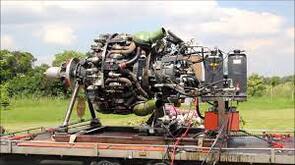curtiSs-wright R-3350 turbo compoUnd engine

The Curtiss-Wright R-3350 Turbo Compound was one of the most powerful radial aircraft engines of its day. Manufactured in the US in the 1940s to the 1960s it was a two row eighteen cylinder, super and turbo charged air cooled engine.
It was the ultimate development of the R-1820 nine cylinder Cyclone, commencing in 1935 with the R-2600 two row fourteen cylinder Twin Cyclone and following later with the R-3350 Turbo Compound.
Development of the R-3350 was slow due to its complexity of design and first flew in 1941, and later began to power the Boeing B-29 and Lockheed Constellation, but reliability was not really achieved until development post WW2, and it became the engine of choice to power most of the emerging civilian transport aircraft.
High power and fuel economy were achieved by Turbo-Compounding produced by using the exhaust gases from six of the eighteen cylinders to drive three Power Recovery Turbines(PRT), connected to the engine crank shaft to give an additional 20% to take off power with no significant increase in fuel consumption, but a 500lb increase to engine weight and a slight increase to overall engine length.
The engines that are still in use are limited in operation to fifty two inches of manifold pressure, giving 2,880hp on 100/130LL (Low Lead) octane fuel. Further development for air racing used a Nitrous Oxide injection 3,200rpm and eighty two inches of manifold pressure to produce 4,500hp.
It was the ultimate development of the R-1820 nine cylinder Cyclone, commencing in 1935 with the R-2600 two row fourteen cylinder Twin Cyclone and following later with the R-3350 Turbo Compound.
Development of the R-3350 was slow due to its complexity of design and first flew in 1941, and later began to power the Boeing B-29 and Lockheed Constellation, but reliability was not really achieved until development post WW2, and it became the engine of choice to power most of the emerging civilian transport aircraft.
High power and fuel economy were achieved by Turbo-Compounding produced by using the exhaust gases from six of the eighteen cylinders to drive three Power Recovery Turbines(PRT), connected to the engine crank shaft to give an additional 20% to take off power with no significant increase in fuel consumption, but a 500lb increase to engine weight and a slight increase to overall engine length.
The engines that are still in use are limited in operation to fifty two inches of manifold pressure, giving 2,880hp on 100/130LL (Low Lead) octane fuel. Further development for air racing used a Nitrous Oxide injection 3,200rpm and eighty two inches of manifold pressure to produce 4,500hp.
TECHNICAL DATA
Type Two row eighteen cylinder radial piston engine
Length 76.26in (1,930mm)
Diameter 55.78in (1,420mm)
Bore and Stroke Bore 6.125in (155mm) and Stroke 6.312in (160mm)
Displacement 3,347 cu in (54.86L)
Dry weight 2,670lbs (1,212kg)
Valve system One inlet and one exhaust overhead valve per cylinder
Supercharger Two speed, single stage
Fuel system Chandler Evans downdraft carburettor
Fuel type 115/145 octane initially thence 100/130 octane
Oil system Dry sump, pressured and scavenged
Power recovery turbines Three spaced at 120 degree intervals giving
150hp each via a fluid drive to the crank shaft.
Power output 2,880hp @ 2,900rpm at take off
Specific power 0,66hp/cu in
Compression ratio 6.85/1
Power to weight ratio 0.82hp/lb
Type Two row eighteen cylinder radial piston engine
Length 76.26in (1,930mm)
Diameter 55.78in (1,420mm)
Bore and Stroke Bore 6.125in (155mm) and Stroke 6.312in (160mm)
Displacement 3,347 cu in (54.86L)
Dry weight 2,670lbs (1,212kg)
Valve system One inlet and one exhaust overhead valve per cylinder
Supercharger Two speed, single stage
Fuel system Chandler Evans downdraft carburettor
Fuel type 115/145 octane initially thence 100/130 octane
Oil system Dry sump, pressured and scavenged
Power recovery turbines Three spaced at 120 degree intervals giving
150hp each via a fluid drive to the crank shaft.
Power output 2,880hp @ 2,900rpm at take off
Specific power 0,66hp/cu in
Compression ratio 6.85/1
Power to weight ratio 0.82hp/lb
